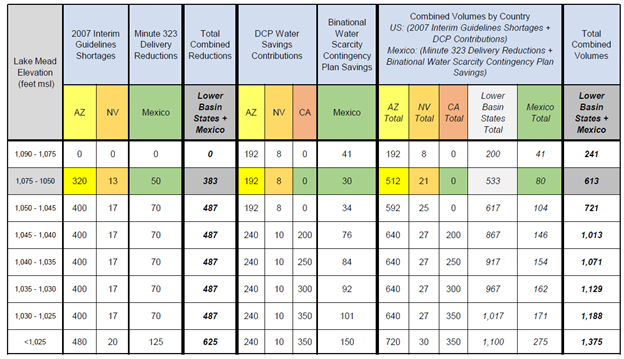Drought and Colorado River Declared Shortage
Southern Nevada relies on the water stored behind our iconic Hoover Dam in Lake Mead to supply our region with drinking water, as well as water for various other uses. Over the last 24 years, the Colorado River has suffered the worst drought in history causing Lake Mead to decline to unprecedented levels. Due to the prolonged lack of precipitation, low snowpack, dry soil conditions and increasing temperatures, the residents and industries located in the lower region of the Colorado River Basin, including southern Nevada, will be required to reduce water use to help maintain critical elevations in Lake Mead.
Through water contracts, shortage guidelines and drought agreements, including the Colorado River Interim Guidelines for Lower Basin Shortages and Coordinated Operations for Lake Powell and Lake Mead (Interim Guidelines) and the Colorado River Drought Contingency Plan (DCP), the Colorado River Commission works closely with the United States Bureau of Reclamation, the Southern Nevada Water Authority and the other basin states, agencies and water users as well as the Republic of Mexico to collaborate and design best drought management practices for future Colorado river water supply for all its many users.
Shortage and Water Savings Contributions to Combat Drought Impacts
The Bureau of Reclamation began implementing the Interim Guidelines in 2007, to govern, amongst other things, how Lake Mead will be operated in times of low reservoir elevations. In a year when a shortage is declared by the Bureau of Reclamation under the Interim Guidelines, Nevada’s consumptive use1 will be reduced depending on Lake Mead elevation. The DCP, which went into effect in 2019, requires water savings contributions in addition to the Interim Guidelines. All of these reductions and contributions are aimed at protecting critical lake levels to ensure an adequate ongoing water supply and continued hydropower production, a valuable green energy source reliant on a sufficient water level for the turbines at Hoover Dam to sufficiently function.
2024 Reductions and Contributions
In calendar year 2024, there is a Level 1 shortage under the 2007 Guidelines and there is a required Drought Contingency Plan contribution for Nevada and Arizona. Accordingly, in 2024, Nevada’s consumptive use will be reduced by 13,000 acre-feet under the 2007 Interim Guidelines and Nevada will make a Drought Contingency Plan contribution of 8,000 acre-feet.2 Arizona and Mexico are also required to take shortage and make a water savings contribution in 2024. Those amounts are significantly larger than Nevada’s obligations. The total combined volumes for Arizona, Nevada, and Mexico are 613,000 acre-feet in calendar year 2024, which will save the equivalent of about 8 feet in elevation in Lake Mead. The reductions and contributions for calendar year 2024 are highlighted in Figure 1.
Despite these significant reductions and contributions, lake levels continued to significantly decrease in elevation (with the exception of 2023). While the current operating guidelines expire at the end of 2026, and the post 2026 operating guideline negotiations are beginning, it became imperative for Reclamation to develop and implement near term actions until the post 2026 guidelines are in place to better protect upper basin resources as well as ensure water deliveries to the lower basin from Glen Canyon Dam. Reclamation, in consultation with the Basin States and input from other stakeholders, is currently preparing to release supplemental operating guidelines to the 2007 Guidelines to address this concern.

Figure 1. Interim Guideline shortages and DCP contributions for elevation ranges in Lake Mead. Reclamation announced that Lake Mead will be operated in the 1075-1050 elevation range for 2024. Reduction volumes for Nevada, Arizona, and Mexico are highlighted.
Over the past 10 years, the Southern Nevada Water Authority has been preparing for river shortages and has done an excellent job in incentivizing water conservation programs, updating water infrastructure, banking conserved water, using water more efficiently and working with our neighbors in Arizona and California and with Mexico in preparation for possible shortage. Because of that effort, Southern Nevada has conserved over 2.3 million acre-feet of Colorado River water for future use and has successfully reduced our consumptive use despite increasing population growth.3 It is critical that we all do our part in conserving water and helping to sustain our lifestyle here in southern Nevada. To better understand the status of our water supply and to stay up to date on current drought conditions and responses, please visit the links provided below.
-
Reclamation
Colorado River Basin -
SNWA
Southern Nevada Water Resources -
SNWA
Conservation Initiatives -
SNWA
Water Shortages -
SNWA
Water Resource Plan -
SNWA
Low lake level pumping station -
Reclamation
Lower Colorado Water Supply Report -
Reclamation
Lower Basin reservoir storage -
Reclamation
Upper Basin reservoir storage - US Drought Monitor (Western United States)
1 Consumptive use is defined as water that is beneficially used and not returned to the system.
2 In calendar year 2024, Lake Mead will be operating in a Tier 1 Shortage (1,075-1,050) which is an improvement from a Tier 2 shortage (1,050-1,045) during calendar year 2023.
3 FSNWA’s 2023 Water Resource Plan is available here.
Last updated September 7, 2023